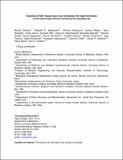Targeting STUB1–tissue factor axis normalizes hyperthrombotic uremic phenotype without increasing bleeding risk
Author(s)
Shashar, Moshe; Belghasem, Mostafa E.; Matsuura, Shinobu; Walker, Joshua; Richards, Sean; Alousi, Faisal; Rijal, Keshab; Kolachalama, Vijaya B.; Odagi, Minami; Nagasawa, Kazuo; Henderson, Joel M.; Gautam, Amitabh; Rushmore, Richard; Francis, Jean; Kirchhofer, Daniel; Sherr, David H.; Ravid, Katya; Chitalia, Vipul C.; Balcells-Camps, Mercedes; Kolandaivelu, Kumaran; Edelman, Elazer R; ... Show more Show less
DownloadManuscript_kFinal_CHIP regulation of TF 7_30_2017 MS + Fig + Supplement copy.pdf (23.75Mb)
OPEN_ACCESS_POLICY
Open Access Policy
Creative Commons Attribution-Noncommercial-Share Alike
Terms of use
Metadata
Show full item recordAbstract
Chronic kidney disease (CKD/uremia) remains vexing because it increases the risk of atherothrombosis and is also associated with bleeding complications on standard antithrombotic/antiplatelet therapies. Although the associations of indolic uremic solutes and vascular wall proteins [such as tissue factor (TF) and aryl hydrocarbon receptor (AHR)] are being defined, the specific mechanisms that drive the thrombotic and bleeding risks are not fully understood. We now present an indolic solute-specific animal model, which focuses on solute-protein interactions and shows that indolic solutes mediate the hyperthrombotic phenotype across all CKD stages in an AHR- and TF-dependent manner. We further demonstrate that AHR regulates TF through STIP1 homology and U-box-containing protein 1 (STUB1). As a ubiquitin ligase, STUB1 dynamically interacts with and degrades TF through ubiquitination in the uremic milieu. TF regulation by STUB1 is supported in humans by an inverse relationship of STUB1 and TF expression and reduced STUB1-TF interaction in uremic vessels. Genetic or pharmacological manipulation of STUB1 in vascular smooth muscle cells inhibited thrombosis in flow loops. STUB1 perturbations reverted the uremic hyperthrombotic phenotype without prolonging the bleeding time, in contrast to heparin, the standard-of-care antithrombotic in CKD patients. Our work refines the thrombosis axis (STUB1 is a mediator of indolic solute-AHR-TF axis) and expands the understanding of the interconnected relationships driving the fragile thrombotic state in CKD. It also establishes a means of minimizing the uremic hyperthrombotic phenotype without altering the hemostatic balance, a long-sought-after combination in CKD patients.
Date issued
2017-10Department
Institute for Medical Engineering and ScienceJournal
Science Translational Medicine
Publisher
American Association for the Advancement of Science (AAAS)
Citation
Shashar, Moshe et al. “Targeting STUB1–tissue Factor Axis Normalizes Hyperthrombotic Uremic Phenotype Without Increasing Bleeding Risk.” Science Translational Medicine 9, 417 (November 2017): eaam8475 © 2017 The Authors
Version: Author's final manuscript
ISSN
1946-6234
1946-6242